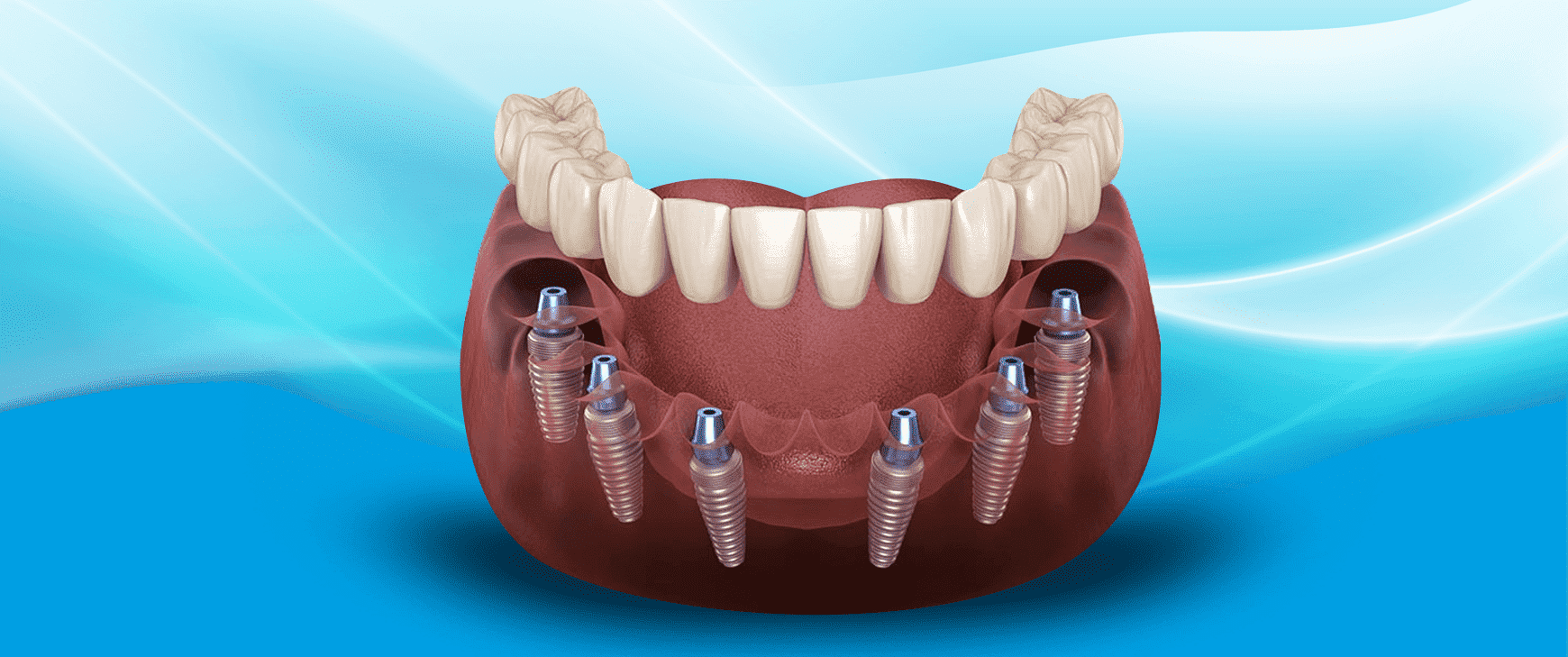What is an All on Six? How Is It Done?
Salih ÖNDER2025-04-01T18:26:12+03:00Introduction to All on Six Dental Implants
All on six dental implants are a full-mouth restoration solution designed for people who have lost most or all of their teeth. This advanced treatment involves the placement of six dental implants in the jaw to support a fixed prosthetic arch. Unlike removable dentures, all on six offers a long-lasting, stable, and natural-looking set of teeth that functions just like real ones.
The procedure is popular among patients seeking a durable alternative to traditional dentures or bridges. With proper care, the results can last for decades, providing both functional and aesthetic improvements to a patient’s oral health.
The All on Six Procedure: Step-by-Step Overview
The all on six process begins with a thorough dental examination, including 3D scans and digital imaging to assess bone structure and plan the implant placement. This ensures a precise and custom-fit approach tailored to each patient’s needs.
The steps include:
Initial consultation and treatment planning
Surgical placement of six titanium implants in the jaw
Temporary teeth placement on the same day or within a few days
Healing period for osseointegration, where the implants bond with the jawbone
Final placement of permanent prosthetic teeth once healing is complete
This entire process may span a few months, depending on individual healing times, but the result is a full set of stable, functional, and attractive teeth.
Benefits of Choosing All on Six Dental Implants
Choosing all on six implants comes with numerous advantages for both oral health and quality of life. Here are some of the key benefits:
Enhanced stability due to six anchoring implants
Improved biting and chewing ability
Natural look and feel compared to traditional dentures
Prevention of further bone loss in the jaw
Permanent solution with proper care and maintenance
Increased confidence and better speech clarity
Because of the additional implants compared to the all on four method, patients may experience even greater stability and strength, especially in cases with higher bone volume.
Ideal Candidates for All on Six Dental Implants
The all on six procedure is best suited for individuals who have lost most or all of their teeth in one or both jaws. Ideal candidates include:
Patients with adequate bone density to support six implants
Individuals looking for a fixed, long-term solution to tooth loss
People who want to avoid the hassle of removable dentures
Patients in overall good health, free from conditions that impair healing
A full assessment by a dental professional is required to determine eligibility. Bone grafting may be necessary in some cases to ensure the jaw can support the implants effectively.
Comparing All on Six to All on Four and Traditional Dentures
Both all on six and all on four offer fixed, implant-supported solutions for full-arch restoration. The main difference lies in the number of implants used—six for the former and four for the latter.
All on six may offer better long-term support and load distribution, especially for patients with strong bone structure. On the other hand, all on four is often preferred for patients with minimal bone density or those looking for a slightly quicker, less invasive solution.
Compared to traditional dentures, both implant-based options offer:
Greater stability and comfort
No need for adhesives or removal
Improved facial structure preservation
Enhanced ability to chew and speak naturally
Choosing between all on six, all on four, and dentures depends on various factors, including bone health, budget, and individual preferences.
Post-Procedure Care and Maintenance for All on Six

Caring for your all on six implants after surgery is crucial to ensure proper healing and long-term success. The initial recovery period may include mild swelling, discomfort, and dietary restrictions, all of which are manageable with guidance from your dental team.
Post-procedure care includes:
Eating soft foods during the first few weeks
Taking prescribed medications as directed
Avoiding smoking or alcohol to support healing
Using a soft-bristled toothbrush and non-abrasive toothpaste
Rinsing gently with salt water or a recommended mouthwash
In the long term, maintaining good oral hygiene is key. Brushing and flossing daily, combined with regular dental checkups, will help keep your all on six implants clean, functional, and healthy for many years.
Potential Risks and Complications of All on Six
While all on six implants are generally safe and successful, like any surgical procedure, there are some risks to consider. Most complications are rare and can be minimized by choosing an experienced implant dentist.
Potential risks include:
Infection at the implant site
Swelling, bruising, or bleeding after surgery
Implant failure due to poor bone integration
Sinus complications for upper jaw placements
Temporary numbness or discomfort in the surrounding areas
Following your dentist’s aftercare instructions closely and attending follow-up appointments will help reduce the chance of complications and ensure your recovery progresses smoothly.
Success Rates and Longevity of All on Six Implants
All on six implants have a high success rate, often above 95 percent when placed and maintained properly. The longevity of this treatment is one of its biggest advantages, with many patients enjoying their implants for 15 to 25 years or longer.
Several factors influence the long-term success of all on six, including:
The patient’s overall health and lifestyle
The skill of the dental surgeon
Daily oral hygiene practices
Regular dental check-ups and professional cleanings
While the implant posts are designed to last decades, the prosthetic teeth may require maintenance or replacement over time due to normal wear.
Cost Considerations and Insurance Coverage for All on Six
The cost of all on six implants can vary based on location, clinic reputation, and materials used. Prices can be significantly lower in countries popular for dental tourism, such as Turkey.
Factors that affect cost include:
Type of prosthetic (acrylic, zirconia, or porcelain)
Pre-treatment procedures like bone grafts or extractions
Anesthesia and post-op care
Whether the treatment is single or dual arch
Most dental insurance plans do not fully cover all on six implants, as they are often considered elective or cosmetic. However, partial coverage for extractions, imaging, or consultations may apply. It’s important to verify benefits with your provider before starting treatment.
Patient Testimonials and Case Studies on All on Six
Patient feedback on all on six implants is overwhelmingly positive. Many individuals who struggled with uncomfortable dentures or advanced tooth loss report significant improvements in quality of life, confidence, and comfort after the procedure.
Common themes in testimonials include:
Regaining the ability to eat and speak freely
Feeling confident in their smile again
Appreciating the fixed, natural feel of the prosthetic
Minimal discomfort during and after the procedure
Case studies often highlight successful outcomes in patients with varying degrees of tooth loss, bone density, or health challenges. These real-world examples help showcase the effectiveness and reliability of the all on six solution.
Here’s the final part of your SEO article using the keyword all on six, structured to match your style preferences and formatting requirements:
Advancements in All on Six Implant Technology

Recent advancements in dental implant technology have greatly enhanced the effectiveness and accessibility of all on six treatments. Modern techniques now allow for faster procedures, shorter recovery times, and more natural-looking results.
Key innovations include:
3D imaging and digital planning for precise implant placement
Improved implant surfaces that promote faster bone integration
Computer-guided surgery for reduced risks and better accuracy
High-quality prosthetic materials like zirconia for durability and aesthetics
These technological improvements not only increase the success rate but also provide a better overall experience for patients undergoing all on six procedures.
Is All on Six Better Than All on Four?
Both all on six and all on four are effective solutions for full-arch dental restoration. The main difference lies in the number of implants used—six versus four—which impacts the level of support and stability.
All on six is generally considered the better option for patients with good bone density, as it provides:
Enhanced strength and support due to additional implants
Better load distribution during chewing
Increased longevity of the prosthetic structure
However, all on four might be more suitable for individuals with limited bone volume or those seeking a slightly less complex procedure. A consultation with a qualified implant dentist is the best way to determine which option is right for each patient.
How Long Does the All on Six Procedure Take?
The timeline for all on six varies depending on the patient’s oral health and whether additional treatments are needed, such as extractions or bone grafts. In general, the procedure follows this timeline:
Initial consultation and diagnostics: 1 to 2 visits
Implant surgery: 1 appointment
Temporary teeth placement: same day or within a few days
Healing and osseointegration: 3 to 6 months
Final prosthesis placement: once healing is complete
From start to finish, most patients complete the all on six process within 4 to 8 months.
It might interest you –> Antalya Dental Clinic
What to Expect During Recovery From All on Six Implants
Recovery from all on six implants is typically straightforward but varies by individual. Mild swelling, soreness, and bruising are common in the first few days after surgery and can be managed with prescribed medication and rest.
During recovery, patients should:
Eat soft foods to avoid putting pressure on the implants
Maintain gentle but thorough oral hygiene
Avoid smoking and alcohol, which can delay healing
Follow up with their dentist to monitor progress
Most patients feel significantly better within a week, and the healing process continues quietly as the implants integrate with the jawbone.
For your information –> Hollywood Smile Turkey
Can You Eat Normally With All on Six Dental Implants?
Yes, one of the greatest benefits of all on six dental implants is the ability to eat normally after recovery. Once the final prosthetic teeth are in place and the jaw has fully healed, patients can enjoy a wide range of foods without worry.
Immediately after surgery, however, patients are advised to follow a soft diet to avoid disturbing the healing implants. Over time, they can gradually return to harder, chewier foods.
Unlike traditional dentures, all on six implants are fixed in place, providing strong bite force and stability. This allows patients to eat comfortably and confidently without fear of slipping or irritation.
Click and learn –> All on Four
Treatment Summary
Number of Transactions
2-3
Return to Work Process
Now
Processing Time
10 Days
Full Recovery Process
Now
Anesthesia Method
Local anesthesia
Persistence of Results
5 Years
Sensitivity Process
Non
Eating - Drinking Process
2 Hours Later
Note: *The information and recommendations on this page are for informational purposes only. Please consult your doctor for diagnosis and treatment. WhatsApp line.
Bütün İşimiz Diş


